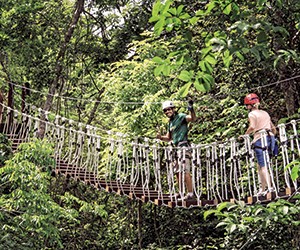At just 100 miles long by 35 miles wide, Puerto Rico proves the old saying about good things coming in small packages.
As the easternmost and smallest of the Greater Antilles, the U.S. territory packs a potent variety that includes mountaintops and ocean depths, urban energy and wilderness seclusion, rainforests and deserts, glittering casinos and colonial heritage sites. Not to mention the beaches that shimmer under a tropical sun and the underground caves the sun never touches.
“Puerto Rico has the ability to create a revolution of the senses,” says Milton Segarra, newly appointed president and CEO of the Puerto Rico Convention Bureau. “There is a vibe here, a constant beat. We like to have a great time and we try to pass that on to our visitors.”
With an ever-evolving convention center district in place, including the headquarter Sheraton Puerto Rico Hotel & Casino and the upcoming Hyatt House San Juan, Segarra is committed to giving attendees an experience they can “take back” when they leave Puerto Rico.
“We ask ourselves, ‘What is going to stick with the visitor?’ And we realize that our island has the ability to take visitors’ desires to a new level,” he says. “We meet their expectations, and we exceed them. It’s about the ‘wow’ effect. We have that, which is important if you want to compete.”
Following are just a few examples of some activities that should have your group saying “wow.”
Become a Foodie
With its colonial-era forts and cobblestone streets, most travelers would consider Old San Juan a must-stop on any travel itinerary. But you can combine the past and present on a Flavors of San Juan food and culture tour that not only explores this UNESCO World Heritage city but samples some of the island’s most iconic dishes, from the signature rice and beans to mofongo, made with fried green plantains and drenched in a savory chicken creole sauce.
The three-hour tours, which stop at six local restaurants, are ideal for time-sensitive convention programs.
“It’s perfect for that person who doesn’t have a lot of time in San Juan. They want to see the sights and learn about the oldest city, but they also want to go out to eat,” says Mikol Hoffman, manager of the company. “It’s your best shot at everything.”
Company guides are well versed in architecture, history and the culinary arts, Hoffman says, and steer clients to the “mom and pop” restaurants that the average tourist might miss.
Tours start at 4:30 p.m. and depart every 30 minutes. Large groups can be staggered, or private tours can be arranged. In mid-October, Flavors of San Juan launched its its first day tours, starting at 10:30 a.m. and running every half hour.
But if you want to become your own expert in Puerto Rican cuisine, the company also conducts three-hour “Chef for a Day” cooking classes, teaching students to prepare a full menu that includes appetizers, main courses, desserts and even cocktails. Up to 20 participants can be accommodated in a rooftop location that overlooks the ocean in San Juan’s Isla Verde neighborhood, five minutes from the airport.PageBreak
An Environmental
Ambassador
Jean-Michel Cousteau’s Ambassadors of the Environment, a new program at Dorado Beach, a Ritz-Carlton Reserve, immerses guests in the natural wonders of land and sea as well as cultural history, as a pre-Columbian Taino Indian archaeological site is directly on the property.
“The most popular is activity is snorkeling, and there’s an evening snorkeling program as well,” says Isabel Gracia, director of sales and marketing for Dorado Beach. Groups may also participate in surveys of local birds, take photography expeditions, go kayaking on the ocean and hike through nearby forests.
The Ambassadors program fits in nicely with the general eco philosophy of The Ritz-Carlton Reserve sub-brand, whose locations are chosen carefully, Gracia says.
Dorado Beach, in fact, was built on the footprint of a property once owned by Laurance Rockefeller, a member of the famous family who was also noted for his advocacy of conservation issues.
Another advantage of this particular property?
“Our location directly on the beach was ‘grandfathered’ in,” Gracia says. “Hotels are not allowed to build so close to the beach anymore.”
Ambassador programs are open to everyone, not just hotel guests, though planners are advised to make arrangements well in advance.
An Expert on Rum
Whether or not you’re a fan of rum, you’re bound to enjoy touring Casa Bacardi, touted as the largest rum distillery in the world and as much a history lesson as an exploration of the amber spirit that infuses many a tropical drink.
Bacardi rum started with the Bacardi family in Cuba in 1862, but the drink goes back to 17th-century sugar cane plantations across the Caribbean, where it was discovered that molasses, a byproduct of the sugar refining process, could be fermented into alcohol.
Such historical moments in spirit making and more are explored on the tour, along with a reproduction of the Bacardis’ first distillery and a tutorial on the fine points of rum making. The tour ends with bartenders mixing up complimentary rum drinks—among them, mojitos, Cuba Libres and Mori Sonandos, a combination of Bacardi Orange, cream of coconut, pineapple and orange juice. Group tours are offered at the plant, and many local tour operators include it as a stop as well. PageBreak
A Fearless Flyer
A lush, mountainous terrain makes the Puerto Rican landscape more than simply picturesque—it’s prime ziplining territory. And like everything else on this compact island, the adventure is close at hand.
“We have seven ziplines five minutes away from San Juan,” says Ivan Purcell, owner of Ecoquest Adventures & Tours, featuring a Campo Rico Ziplining Adventure that includes a kayak trek and a hike along the limestone formations of Puerto Rico’s unique karst topography before reaching the starting point of an exhilarating ride that soars past ocean vistas, plantain fields and lagoons. Visitors also enjoy hiking in between the ziplines, which vary in height and length. But don’t be sorry when the ride ends.
“Our last zipline ends in the mojito bar, and we take your drink order before you start,” Purcell says.
A homemade lunch of Puerto Rican favorites also may be savored after the ride, and everyone gets a water bottle sporting the company logo.
In the heart of Puerto Rico’s mountainous interior, Toro Verde Adventure Park (www.toroverdepr.com) combines extreme thrills like rapelling and rock climbing with its zipline adventures.
“They have a zipline that’s more than 4,000 feet long and it’s 850 up in the mountains,” says the Puerto Rico Convention Bureau’s Segarra. “You really believe you’re flying.”
The Next Indiana Jones
Expect solid ground, but plenty of action, at El Yunque National Forest, the only tropical rainforest in the U.S. National Forest system, set just southeast of San Juan. Scenic roadways and nature trails get visitors close to untold numbers of birds, bats, lizards, tree frogs and snails with shells as big as a child’s fist.
“It’s the most biodiverse forest in the tropics,” says Forest Supervisor Pablo Cruz. “We don’t have the same species you see in Costa Rica or the Amazon. We don’t have the leopards and the primates, which actually makes it one of the most friendly rainforests in the world. And we’re so close to the coast, you get the most spectacular views of the eastern end of the Antilles.”
El Yunque also boasts the El Portal Rain Forest Center, which is available for group rentals.
While El Yunque is a rainforest, the most typical kind in Puerto Rico, the Guanica State Forest & Biosphere Reserve (787.821.5706) is dry. Still, this 9,000-acre coastal wilderness is lush in its own way, with trees and shrubs mixed in with cacti and other plants. Trails lead to caves, beaches and historical sites, including an old fort built by the Spanish. mf






